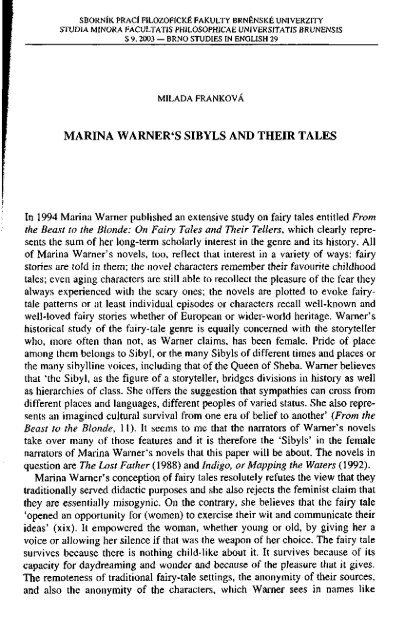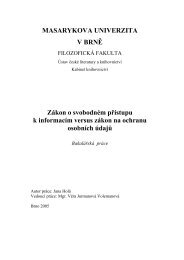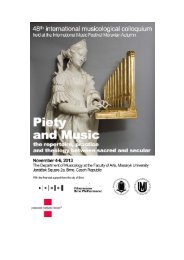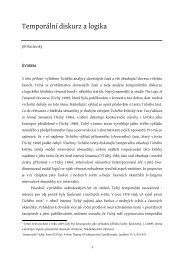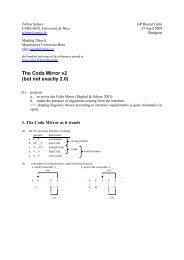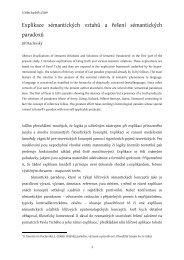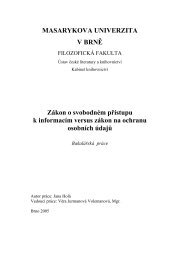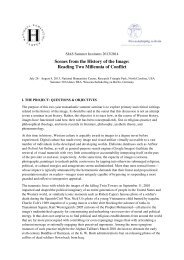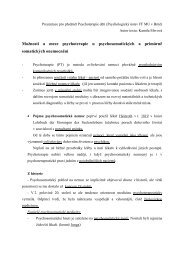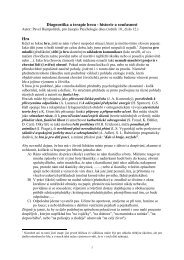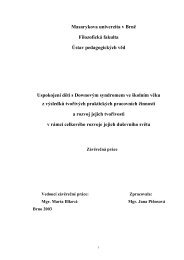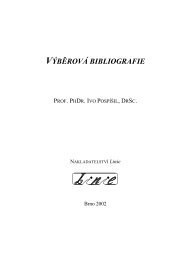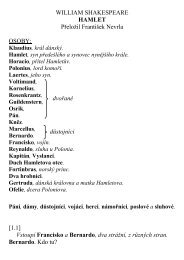MARINA WARNER'S SIBYLS AND THEIR TALES
MARINA WARNER'S SIBYLS AND THEIR TALES
MARINA WARNER'S SIBYLS AND THEIR TALES
Create successful ePaper yourself
Turn your PDF publications into a flip-book with our unique Google optimized e-Paper software.
SBORNÍK PRACÍ FILOZOFICKÉ FAKULTY BRNĚNSKÉ UNIVERZITY<br />
STUDIA MINORA FACULTATIS PHILOSOPHICAE UNIVERSITATIS BRUNENSIS<br />
S 9, 2003 — BRNO STUDIES IN ENGLISH 29<br />
MILADA FRANKOVÁ<br />
<strong>MARINA</strong> <strong>WARNER'S</strong> <strong>SIBYLS</strong> <strong>AND</strong> <strong>THEIR</strong> <strong>TALES</strong><br />
In 1994 Marina Warner published an extensive study on fairy tales entitled From<br />
the Beast to the Blonde: On Fairy Tales and Their Tellers, which clearly represents<br />
the sum of her long-term scholarly interest in the genre and its history. All<br />
of Marina Warner's novels, too, reflect that interest in a variety of ways: fairy<br />
stories are told in them; the novel characters remember their favourite childhood<br />
tales; even aging characters are still able to recollect the pleasure of the fear they<br />
always experienced with the scary ones; the novels are plotted to evoke fairytale<br />
patterns or at least individual episodes or characters recall well-known and<br />
well-loved fairy stories whether of European or wider-world heritage. Warner's<br />
historical study of the fairy-tale genre is equally concerned with the storyteller<br />
who, more often than not, as Warner claims, has been female. Pride of place<br />
among them belongs to Sibyl, or the many Sibyls of different times and places or<br />
the many sibylline voices, including that of the Queen of Sheba. Warner believes<br />
that 'the Sibyl, as the figure of a storyteller, bridges divisions in history as well<br />
as hierarchies of class. She offers the suggestion that sympathies can cross from<br />
different places and languages, different peoples of varied status. She also represents<br />
an imagined cultural survival from one era of belief to another' (From the<br />
Beast to the Blonde, 11). It seems to me that the narrators of Warner's novels<br />
take over many of those features and it is therefore the 'Sibyls' in the female<br />
narrators of Marina Warner's novels that this paper will be about. The novels in<br />
question are The Lost Father (1988) and Indigo, or Mapping the Waters (1992).<br />
Marina Warner's conception of fairy tales resolutely refutes the view that they<br />
traditionally served didactic purposes and she also rejects the feminist claim that<br />
they are essentially misogynic. On the contrary, she believes that the fairy tale<br />
'opened an opportunity for (women) to exercise their wit and communicate their<br />
ideas' (xix). It empowered the woman, whether young or old, by giving her a<br />
voice or allowing her silence if that was the weapon of her choice. The fairy tale<br />
survives because there is nothing child-like about it. It survives because of its<br />
capacity for daydreaming and wonder and because of the pleasure that it gives.<br />
The remoteness of traditional fairy-tale settings, the anonymity of their sources,<br />
and also the anonymity of the characters, which Warner sees in names like
118 MILADA FRANKOVÁ<br />
'Beauty' or 'Fair with the Golden Hair', underpin, in Warner's view, 'the stories'<br />
ability to grapple with reality' (xvi). That is why she favours a historical<br />
interpretation of fairy tales to psychoanalytic or mystical approaches, not least<br />
because the former 'holds out more hope' (xviii). The sense of hope resides in<br />
the overall mood of the tales, which Warner defines as 'optative—announcing<br />
what might be' (xvi). The genre is thus characterised by a "heroic optimism"<br />
that precedes and goes beyond the wondrous happy endings with a promise that<br />
things might change. That they do not change much in reality is of little consequence.<br />
The historical overview of fairy tales and their tellers in motion over<br />
centuries and across continents that Warner offers in her study yields a fascinating<br />
picture of all-encompassing uninterrupted continuity.<br />
The nature of the genre is promiscuous and omnivorous and anarchically<br />
heterogeneous, absorbing high and low elements, tragic<br />
and comic tones into its often simple, rondo-like structure of narrative.<br />
Motifs and plotlines are nomadic, travelling the world and the<br />
millennia, turning up on parchment in medieval Persia, in an oral<br />
form in the Pyrenees, in a ballad sung in the Highlands, in a fairy<br />
story in Caribbean, (xvii)<br />
In her analysis of fairy tales Warner assigns a significant position to the storyteller.<br />
As the seventeenth and eighteenth centuries saw the heyday of the genre<br />
as a literary form, she gives credit to Charles Perrault, a distinguished French<br />
scholar, courtier and poet, for becoming the pioneer teller of fairy tales in the<br />
late seventeenth century, although he was outnumbered and even preceded by<br />
women enthusiasts. Not forgetting other famous male names from Aesop to Andersen,<br />
Warner still insists that throughout history women must have been by far<br />
the most frequent tellers of tales. In spite of the fact that for a long time the 'Silent<br />
Woman was an accepted ideal' (29), and the evil tongue of the old gossip<br />
was its direct opposite, there have been a few women figures who were accorded<br />
the status of acknowledged story tellers. Among them, even the old, traditionally<br />
much despised, woman was given a voice. Perhaps surprisingly for us, Warner<br />
taps our traditional Czech sources for one of them—our much beloved figure of<br />
Granny, whom she traces through Karel Čapek and his views on the origin of<br />
fairy stories (17). Another female story teller—the old nurse—Warner connects<br />
with the time-honoured passing on of erotic knowledge. The English Mother<br />
Goose appears relatively more recently, as late as the end of the eighteenth century,<br />
and with fairy tales exclusively meant for children. Still older than all three,<br />
the Granny, the Old Nurse and Mother Goose, are the Sibyls, whether young or<br />
old, known from Classical cultures, adopted by Christian cultures and accorded<br />
the honourable attributes of wisdom and truthfulness.<br />
The Sibyl is a generic name and implies multiple figures although there may<br />
have been a prophetess of the name Sibylla before the legendary Sibyls of<br />
Marpessus and Cumae. The Pythia of Delphi and Cassandra of Troy are also<br />
sibylline figures. Like the two, the Sibyl in Vergil's Aeneid was given her gift of
<strong>MARINA</strong> <strong>WARNER'S</strong> <strong>SIBYLS</strong> <strong>AND</strong> <strong>THEIR</strong> <strong>TALES</strong> 119<br />
prophecy by Apollo, who also gave her a thousand years to live, alas most of the<br />
time in old age. She accompanied Aeneas to Hades, the Underworld, and although<br />
they returned to the world through a gate of ivory through which 'the<br />
spirits send false dreams up to the sky' (Aeneid 896 cited in Morford and Lenardon<br />
1985: 276), the Sibyl's oracles are trusted. They come from 'a hundred perforations<br />
in the rock, a hundred mouths from which the many utterances rush'<br />
{Aeneid 43-5, Ibid., 163) and are described as 'her terrifying riddles' (Aeneid 98-<br />
99, Ibid., 164). The Sibylline books or oracles, too, have the aura of awe around<br />
them. The texts of the legend, allegedly sold by the Sibyl in Rome to the last<br />
Etruscan king, Tarquin, were to be consulted in difficult times. The power of<br />
such prophecies was recognised by Jewish and Christian imitators, who composed<br />
several books of them to persuade the heathen to believe. The Christians<br />
acknowledge the Sibyls for their foreknowledge of Christ, the Messiah. In this<br />
way, the Sibyl survived for hundreds of years not only in legends but in reality<br />
too, or, as Warner puts it, she has acquired a cross-cultural identity of a truthteller<br />
(From the Beast, 71). The sibylline aspect of the great biblical story teller<br />
the Queen of Sheba is derived from the riddling quality of her tales and her wisdom,<br />
which concentrates, as Warner points out, 'on the mysteries of sex and the<br />
body' (From the Beast, 133).<br />
Michěle Roberts uses all ten Classical Sibyls, although in rather modern<br />
guises, as characters and storytellers in her novel The Book of Mrs. Noah (1987).<br />
In Marina Warner's recreation the links are subtler and less straightforward. In<br />
her earlier novel The Lost Father (1988) the narrator and her mother style themselves<br />
as story-telling Sibyl-like figures. In the mid 1980s the narrator retells her<br />
mother's family story as she knows it from her mother's telling, while she is actually<br />
in the process of rewriting it as a novel called The Duel, which was supposed<br />
to have taken place in a southern Italian village back in 1912. The duel is<br />
a key event in the family history. It was fought by Davide Pittagora, the eponymous<br />
"lost father", then a single young man, to save the honour of his sister<br />
Rosalba, the present narrator's great-aunt. Passed on by the family's women<br />
folk, with some details whispered, others concealed deep in the minds of the protagonists,<br />
the family memory of the event re-emerges in the emigre branch of the<br />
family in the USA seven decades later in a somewhat different shape, but still<br />
the heroic family myth. It is of course not the Sibyl's gift of prophecy that Warner<br />
foregrounds here, but the powerful sense of women's voices transmitting<br />
stories from generation to generation, across time and geographical and cultural<br />
distances.<br />
The sense of story-telling in the novel is underscored by young Rosalba's fantasy<br />
and her gift of recreating fairy tales to fit her own situation. She identifies<br />
with their courageous heroines to give herself the courage to attract young<br />
Tommaso's attention against her mother's will. The interplay of fairy-tale motifs<br />
and sexual attraction echoes Angela Carter's postmodern interpretations of fairy<br />
tales, such as 'Bluebeard' in the story collection The Bloody Chamber (1979).'<br />
Warner also shows how fairy tales as well as myths and superstitions about<br />
women and femaleness passed for common wisdom:
120 MILADA FRANKOVÁ<br />
You know too, my darling, my perfectly formed Rosalba, that what<br />
men do with women isn't worth much, not to women like you and<br />
me. It's another kind of woman, poor things, who are born with<br />
cravings, because their mothers were too much exposed to the hot<br />
wind from the south when they were carying them, and it frothed up<br />
the liquid in their womb, and brought the baby almost to boiling<br />
just at the time when the passions are forming, in the third or fourth<br />
month. (The Lost Father, 24)<br />
Moreover, the Queen of Sheba herself is evoked and the story of her club or<br />
goat's foot and its healing is about to be told in the form of a modern comic opera,<br />
when the performance is stopped by the local Fascist leaders amidst accusations<br />
of immorality, foreignness and lack of patriotic fervour. The significance<br />
of the Queen of Sheba's story half way through the novel lies in its manifold<br />
resonances: with the women's world of the immediate context as well as wider<br />
metaphorical, iconic and mythical meanings. In The Lost Father, more than in<br />
Warner's other fictions, the sibylline storytellers also compete with the iconic<br />
image of the Virgin Mary, whose powerful presence in the south-Italian setting<br />
also reminds us of Warner's earlier work—the novel In a Dark Wood (1977) and<br />
particularly her historical study Alone of All Her Sex: the Myth and the Cult of<br />
the Virgin Mary (1976).<br />
At the beginning of the 1990s, when Warner published the novel Indigo, or<br />
Mapping the Waters, it was no longer a novelty to interpret Shakespeare's The<br />
Tempest in the post-colonial mode. Neither was Warner the first to produce a rewriting<br />
of a canonical text in this manner. Jean Rhys and her Wide Sargasso Sea<br />
(1966) and J. M. Coetzee's Foe (1987) were by then classic examples. Indigo<br />
plays at two temporal and geographical levels: on the Caribbean island of Liamuiga<br />
around 1620 and in London and back on the island, now independent and<br />
called Enfant-Béate, almost 400 years later. At the beginning of the Caribbean<br />
story Warner demythologises the Shakespearean figures of Sycorax, Ariel and<br />
Caliban, giving them almost ordinary lives of tropical islanders who only begin<br />
to resemble Shakespeare's creatures after their cruel encounter with European<br />
civilisation.<br />
Sycorax, her tribe's wise woman and healer, possesses the sibylline attributes<br />
of wielding powers hidden to others. She may also be related to another powerful<br />
female figure of Warner's interest, namely Homer's Circe and her magic of<br />
metamorphosis (Cf. Warner 1999). Later, Sycorax's sibylline voice comes<br />
across centuries as a powerful incantation:<br />
—Oh airs and winds, you bring me stories from the living... HEAR<br />
ME! I once governed you (for so she thinks) and you did as I<br />
wanted... Turn back your currents in their course... so that we can<br />
return to the time before this time. (Indigo, 212)<br />
What is more, throughout the novel Warner manipulates narrative voices to such
<strong>MARINA</strong> <strong>WARNER'S</strong> <strong>SIBYLS</strong> <strong>AND</strong> <strong>THEIR</strong> <strong>TALES</strong> 121<br />
an extent that, almost in agreement with J. A. Cuddon's claim, the progression or<br />
regression of narrative voices is potentially infinite (Cuddon 1999: 572). For<br />
Sycorax's voice eventually merges with that of Serafine, who is an old black<br />
twentieth-century story-telling character. The novel opens in London, with<br />
Serafine telling stories to Miranda—a little girl then—who witnesses Xanthe's<br />
christening and the rather fairy-tale-like prophecy by her godmother. Xanthe's<br />
sorry ending in the Caribbean waters once "mapped" by her seventeenth-century<br />
ancestor fulfils the prophecy and fits the fairy-tale framework of the novel. The<br />
significance of the narrative perspective, the story teller's point of view, which<br />
Warner foregrounds even with regard to fairy tales, is demonstrated on Kit Everard's<br />
diary and letters. In their heroic rhetoric of victorious colonisers, the unglorious<br />
night when a frightened Kit Everard and his men burned Sycorax—an old<br />
woman in her tree house—becomes 'that night he took possession' (Indigo, 162).<br />
A sibylline thread runs also through Warner's first novel of the new Millennium,<br />
The Leto Bundle (2001). It follows the history of rape, expulsion and exile<br />
from Classical mythology to the present migration. The mythological story of<br />
Leto, the Titaness, her rape by Zeus, expulsion, birth of twins and miraculous<br />
survival in a she-wolfs den is repeated, recreated and re-experienced by her<br />
throughout the ages and finally reassembled as a kind of hypertext written up by<br />
scribes, chroniclers, storytellers, archeologists and scholars, now complete with<br />
web pages and e-mail messages. Through The Leto Bundle Warner makes a<br />
powerful topical plea against entrenched national identities and in favour of toleration<br />
towards migrants, which she supports by driving home her lesson on<br />
what 'a mish mash of traditions', 'a tangle of paganism and Christianity, of fantasy<br />
and fact' {The Leto Bundle, 329) we all really come from. The novel's heroine<br />
Leto-Laetitia-Ella-Nellie draws on the stories to survive and is created by<br />
them.<br />
To sum up, in contrast to Levi-Strauss's structuralist claim that myths possess<br />
their own truth and logic because they are 'outside' (Cuddon 1999: 570), Marina<br />
Warner makes myths and fairy tales bear on reality both in her historical studies<br />
and her novels. The latter, in particular The Lost Father and Indigo, but not forgetting<br />
The Leto Bundle, employ narrative voices, characters and plots that blend<br />
with sibylline storytellers and fairy-tale motifs. Warner's Sibyls range from evocations<br />
of the Classical riddling prophetesses to the biblical Queen of Sheba to<br />
fairy Godmothers and postmodern, metafictional women writers. All of them<br />
have become part of the process of moving fairy tales and myths forward in their<br />
thousands of years of development and metamorphoses.<br />
Note<br />
' However, in her study on Carter's fairy tales, Warner traces and appreciates development in<br />
Carter's approach in a shift in her interest from subconscious and forbidden passions to the<br />
materiality of life. In Lorna Sage (ed), Flesh and the Mirror. Essays on the Art of Angela<br />
Carter. Virago 1994, 243-256.
122 MILADA FRANKOVÁ<br />
Works Cited<br />
Warner, Marina. The Lost Father. London: Chatto and Windus 1988; Vintage 1998.<br />
Warner, Marina. Indigo, or Mapping the Waters. London: Chatto and Windus 1992; Vintage 1993.<br />
Warner, Marina. From the Beast to the Blonde: On Fairy Tales and Their Tellers. London: Chatto<br />
and Windus 1994; Vintage 1995.<br />
Warner, Marina. The Leto Bundle. London: Chatto and Windus 2001; Vintage 2002.<br />
Warner, Marina (1999) 'Magic and Metamorphosis: Circe's Wand, Aesop's Wit'. PA' Review<br />
(Manchester), May-June 1999, 14-22.<br />
Cuddon, J. A. (1999) Dictionary of Literary Terms. Harmondsworth: Penguin Books.<br />
Morford, Mark P. O., and Robert J. Lenardon (1985), Classical Mythology. 3 rd edition. New York:<br />
Longman.


